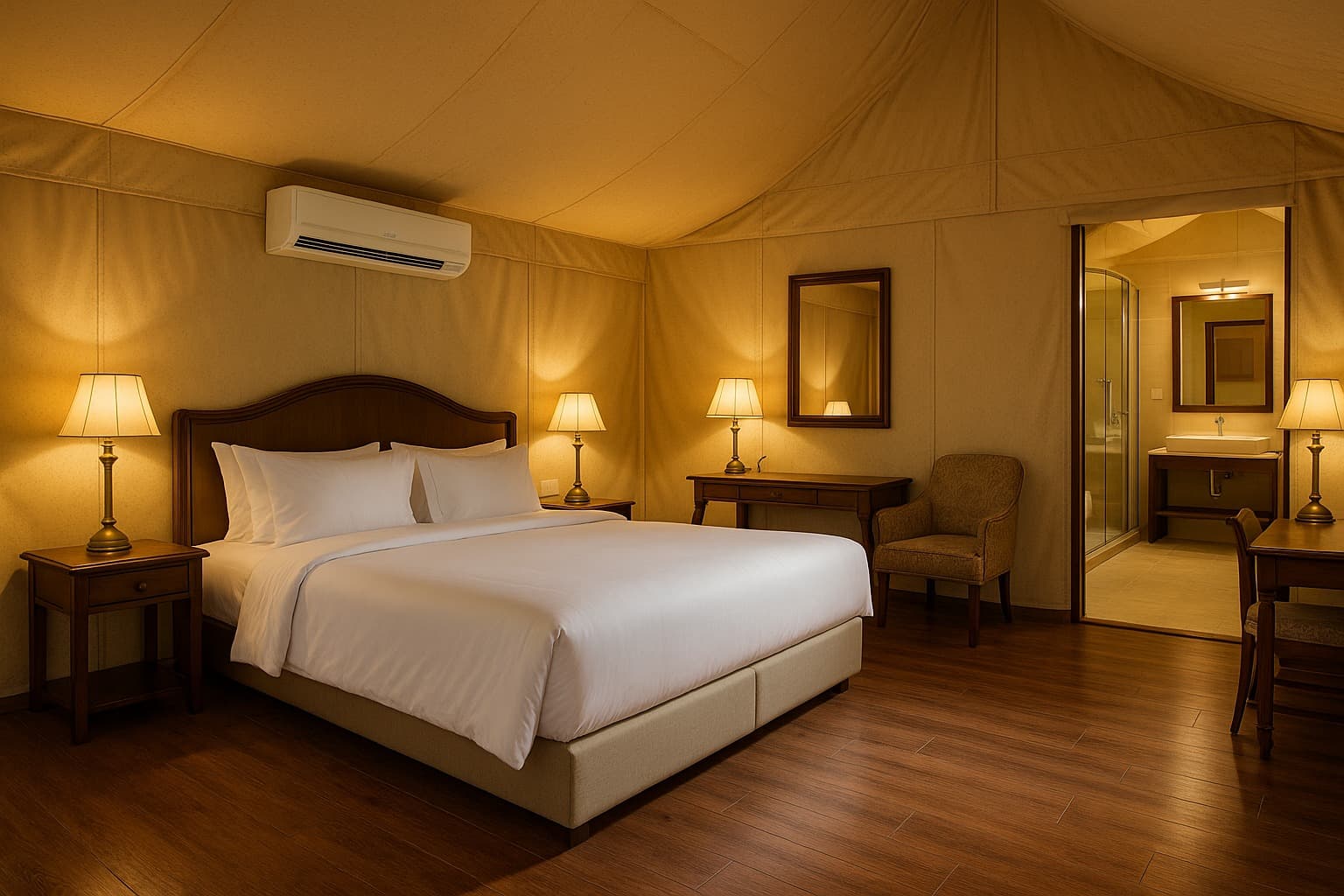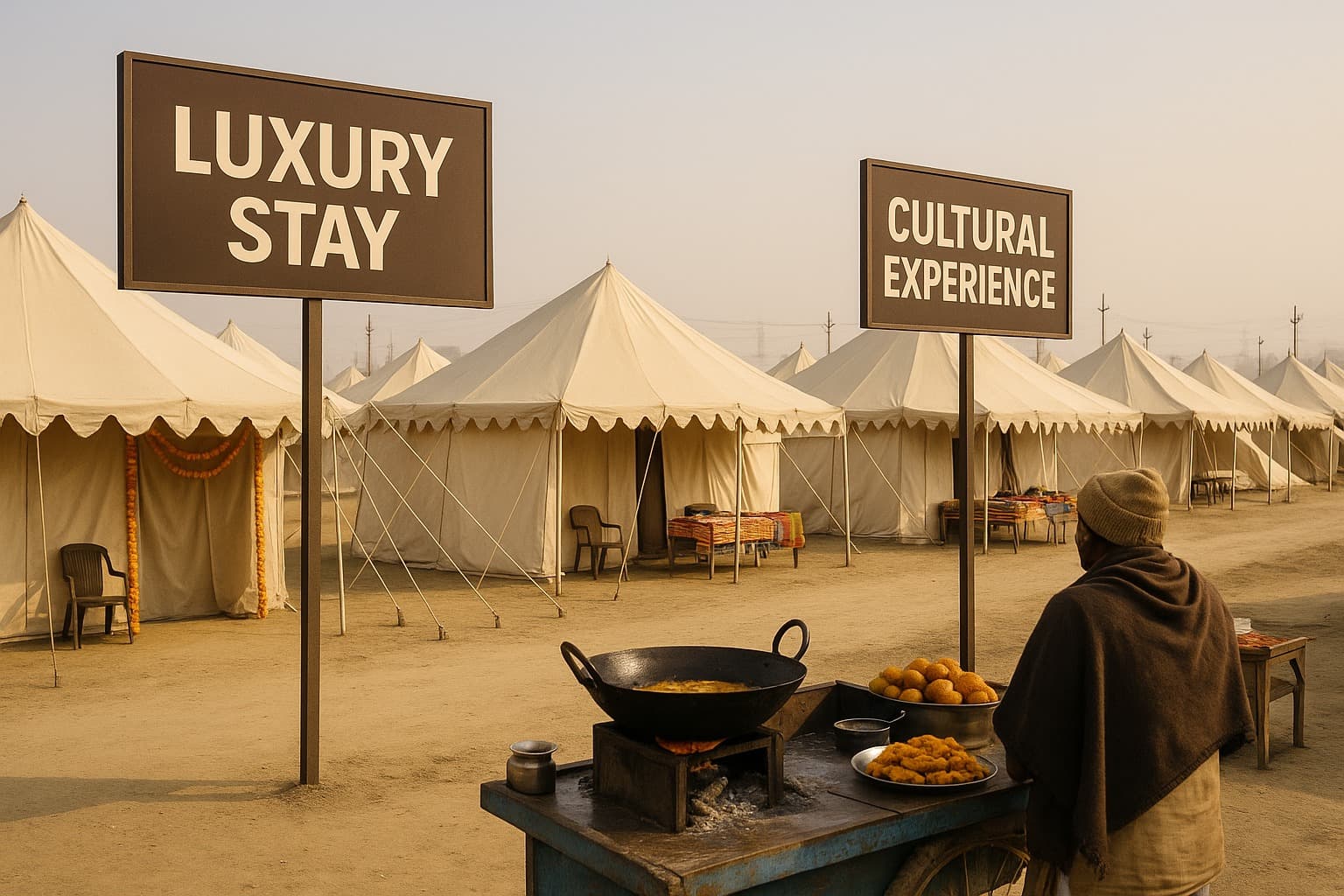Mahakumbh Mela 2025: Ultra-Luxury Tents and the Evolution of Spiritual Tourism
Summary
Mahakumbh Mela 2025 blends spirituality with luxury via high-end tent accommodations costing up to ₹1 lakh. These tents offer comfort and curated experiences for NRIs and global travelers, boosting local tourism and redefining spiritual journeys.

Mahakumbh Mela 2025: A Stay at an Ultra Luxury Tent in Prayagraj May Put You Back by Almost a Lakh
The Mahakumbh Mela 2025 in Prayagraj is being spoken of not just as the world’s largest spiritual gathering but also as one of the most ambitious experiments in religious tourism and luxury hospitality. Traditionally, the Kumbh is associated with simplicity — pilgrims walking barefoot, saints meditating on riverbanks, and devotees waiting hours for a dip in the holy Sangam. But as India changes, so does the way people experience its biggest festivals. This year, alongside the millions who will live in basic tents and dharamshalas, there will also be a set of travelers staying in ultra-luxury tents costing nearly ₹1 lakh per night.
For many, the very idea of a tent with such a price tag feels surprising. But these tents are not the kind you imagine at a campsite. They are fully furnished suites with hotel-like comforts, created to give spiritual seekers, NRIs, and high-end travelers an exclusive way to witness the Mahakumbh.
The World’s Largest Spiritual Gathering
The Kumbh Mela is not an ordinary festival. It is a tradition that stretches back thousands of years and is recognized by UNESCO as an Intangible Cultural Heritage of Humanity. Every 12 years, the Mahakumbh at Prayagraj becomes a meeting point for faith, culture, and humanity itself.
In 2025, more than 40 crore pilgrims are expected to gather in Prayagraj across the course of the event. The Sangam — the confluence of the Ganga, Yamuna, and the mythical Saraswati — becomes the focal point where people come for the holy dip, believed to wash away sins and offer spiritual liberation.
The scale of arrangements is mind-boggling. Entire cities are built from scratch: tent colonies, roads, sanitation systems, security outposts, and food zones. For the government, it is both a logistical challenge and a cultural responsibility. And within this temporary city lies something new — luxury tented accommodations that redefine how people can experience spirituality.
What Are These Ultra Luxury Tents?
Imagine walking into a tent but finding king-sized beds, air-conditioning, Wi-Fi, attached bathrooms with hot water, wooden flooring, elegant furnishings, 24/7 housekeeping, and fine dining facilities. This is what the ultra-luxury tent experience at Mahakumbh 2025 promises.

Developers have created “Tent Cities” that look less like camps and more like high-end resorts. Each tent is equipped with modern amenities, and the sites also feature lounges, yoga decks, spas, curated cultural evenings, and private security. For wealthy travelers or NRIs who wish to experience the spiritual grandeur without giving up comfort, these tents are becoming the first choice.
The cost? Nearly ₹1 lakh per night for the most premium category. For those seeking slightly less indulgence, semi-luxury tents are available at lower prices, starting from ₹25,000–₹40,000 a night.
Why Are People Paying This Much?
On the surface, paying such a huge amount for a tent at a spiritual gathering might seem excessive. But demand exists, and it is growing. There are several reasons:
Convenience in Chaos: With crores of people arriving, staying in basic camps means long queues, shared facilities, and unpredictable arrangements. Luxury tents offer comfort and privacy.
Exclusivity: For many wealthy families, NRIs, or foreign visitors, the Kumbh is a once-in-a-lifetime event. Experiencing it without stress feels worth the cost.
Safety and Security: High-profile individuals prefer secure accommodations, and luxury tents ensure controlled access, private transport, and dedicated staff.
Cultural Packages: Many luxury stays include guided tours, boat rides at Sangam, evening aarti viewings, and curated interactions with saints and scholars.
In short, it is not just a bed you are paying for — it is an entire curated spiritual journey, packaged with luxury.
The Contrast of Simplicity and Luxury
There is an emotional dimension to this as well. The Kumbh has always been about simplicity — about shedding material desires and surrendering at the feet of the divine. So when ultra-luxury tents costing ₹1 lakh appear next to free shelters for sadhus and devotees, it creates an interesting contrast.
Some traditionalists argue that spirituality should not be packaged with five-star experiences. Others, however, see no harm — after all, different people approach faith differently. For NRIs or global travelers, these tents make the Kumbh more accessible.
In fact, this blend of faith and luxury tourism is part of a wider trend in India, where pilgrimage destinations like Varanasi, Rishikesh, and Tirupati are witnessing high-end hotels, retreats, and wellness resorts. The idea is simple: devotion doesn’t have to be uncomfortable; it can be experienced with dignity and comfort.
Economic Impact of Luxury Stays at Kumbh
The Mahakumbh Mela is not only a religious event but also an economic engine. Every edition generates thousands of crores in tourism revenue, provides jobs, and boosts small businesses. Luxury tents add another layer to this ecosystem.
They attract high-spending tourists who contribute significantly to the local economy.

They create opportunities for hospitality professionals, artisans, and service providers.
They put Prayagraj on the global map as not just a spiritual destination but also a cultural-luxury experience.
Government officials see this as part of India’s tourism growth story — blending heritage with modern hospitality.
The Human Side of the Experience
For those who can afford it, staying in such tents is not only about luxury. Many describe it as a unique way of experiencing faith in comfort. After a day of walking to the Sangam, standing in queues, and soaking in the intense energy of the mela, returning to a peaceful, well-furnished tent can be a relief.
Guests also get to enjoy cultural evenings, where folk artists perform, yoga sessions are organized, and traditional food is served with modern presentation. For global visitors, this becomes a way to connect deeply with Indian culture while avoiding the fatigue of crowded conditions.
Looking Ahead: The Future of Luxury at Religious Festivals
The rise of ultra-luxury tents at the Mahakumbh reflects a bigger change — the transformation of religious festivals into global tourism opportunities. India is recognizing that pilgrims are not only devotees but also travelers with diverse expectations.
In the future, we may see more collaborations between hospitality chains and festival organizers, offering everything from eco-friendly luxury pods to wellness retreats around events like Kumbh, Vaishno Devi yatra, and Jagannath Rath Yatra.
For many, this raises a philosophical question: Should spirituality come with luxury? The answer may not be simple. But what’s clear is that the demand exists, and it is shaping the future of India’s religious tourism.
Summary
The Mahakumbh Mela 2025 in Prayagraj will see an interesting mix of tradition and modernity. Alongside millions of devotees living in simple camps, some will stay in ultra-luxury tents priced at nearly ₹1 lakh per night. These tents come with five-star facilities — air-conditioning, private bathrooms, fine dining, cultural evenings, and guided tours — designed for NRIs, wealthy families, and global travelers.
While the idea of such luxury at a deeply spiritual festival may seem unusual, it reflects India’s growing blend of faith and tourism. Luxury accommodations are making the Kumbh more accessible to those who want devotion without discomfort. At the same time, they are boosting the local economy, creating jobs, and putting Prayagraj on the world map for high-end cultural tourism.
In the end, whether one stays in a humble camp or a luxurious tent, the essence of the Mahakumbh remains the same: a chance to witness one of humanity’s grandest gatherings and experience the spiritual energy of the holy Sangam.
